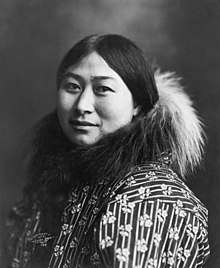Eskimo
Eskimo (/ˈɛskɪmoʊ/ ESS-kih-moh) or Eskimos are the Indigenous circumpolar peoples who have traditionally inhabited the northern circumpolar region from eastern Siberia (Russia) to Alaska (United States), Northern Canada, Nunavik and Greenland.[1][2]
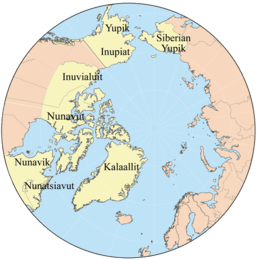 Map of the Inuit Circumpolar Council of Eskimo peoples, showing the Yupik (Yup'ik, Siberian Yupik) and Inuit (Iñupiat, Inuvialuit, Nunavut, Nunavik, Nunatsiavut, Greenlandic Inuit) | |
| Total population | |
|---|---|
| 183,500 | |
| Regions with significant populations | |
| Russia - Chukotka Autonomous Okrug - Sakha (Yakutia) United States - Alaska Canada - Newfoundland and Labrador - Northwest Territories - Nunavut - Quebec - Yukon (formerly) Greenland | |
| Languages | |
| Russian, English, French, Danish, Greenlandic and other Eskimo–Aleut languages. | |
| Religion | |
| Christianity (Russian Orthodox Church, Orthodox Church in America, Roman Catholicism, Anglican Church of Canada, Church of Denmark), Animism | |
| Related ethnic groups | |
| Aleut |
| External video | |
|---|---|
The two main peoples known as "Eskimo" are the Inuit (including the Alaskan Iñupiat peoples, the Greenlandic Inuit, and the mass-grouping Inuit peoples of Canada) and the Yupik (of eastern Siberia[3] and Alaska). A third northern group, the Aleut, is closely related to both. They share a relatively recent common ancestor and a language group (Eskimo-Aleut).
The non-Inuit sub-branch of the Eskimo branch of the Eskimo-Aleut language family consists of four distinct Yupik languages, two used in the Russian Far East and St. Lawrence Island, and two used in western Alaska, southwestern Alaska, and the western part of Southcentral Alaska. The extinct language of the Sirenik people is sometimes argued to be related to these.
According to recent genomic research, the Chukchi people, from eastern Siberia, are the closest living relatives of the Siberian Yupik and the Indigenous peoples of the Americas generally.[4]
There are more than 183,000 people of Eskimo descent alive today,[5][6][7][8][9] of which 135,000 or more live in or near the traditional circumpolar regions.[10] The NGO known as the Inuit Circumpolar Council claims to represent 180,000 people.[11]
The governments in Canada[12][13][14] and the United States[15][16] have made moves to cease using the term "Eskimo" in official documents, but it has not been entirely eliminated, as the word is in some places written into tribal, and therefore national, legal terminology.[17] Canada officially uses the term "Inuit" to describe the native people living in the country's northernmost sector.[12][13] The United States government legally uses "Alaska Native"[16] for the Yupik, Inuit, and Aleut, but also for non-Eskimo indigenous Alaskans including the Tlingit, the Haida, the Eyak, the Tsimshian, in addition to at least nine separate northern Athabaskan/Dene peoples. The designation "Alaska Native" applies to official tribal members only,[18] in contrast to individual Eskimo/Aleut persons claiming descent from the world's "most widespread aboriginal group".[19][20][21]
Description
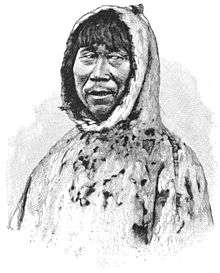
Etymologically speaking, there exists a scientific consensus that the word Eskimo comes from the Innu-aimun (Montagnais) word ayas̆kimew meaning "a person who laces a snowshoe" and is related to "husky" (a breed of dog), and it does not have a pejorative meaning in origin.[22][23][24][25][2]
In Canada and Greenland, the term "Eskimo" is predominantly seen as offensive or "non-preferred", and has been widely replaced by the term "Inuit" or terms specific to a particular group or community.[26][27][28] This has resulted in a trend whereby some Canadians and Americans believe that they should not use the word "Eskimo", and use the classifier and typical Canadian word "Inuit" instead, even for Yupik (non-Inuit) people.[29]
Some people still believe that Eskimo translates to "eater of raw meat", which may be seen, or used, in a pejorative way.[12][30][31][32][33] The word has been cited by some authors as being used by colonizers in the process of committing cultural and emotional genocide.[34][35][36]
Section 25[37] of the Canadian Charter of Rights and Freedoms and section 35[38] of the Canadian Constitution Act of 1982, recognized the Inuit as a distinctive group of Aboriginal peoples in Canada.
The Inuit Circumpolar Council voted to replace the word "Eskimo" with "Inuit" in 1977,[39] but even at that time such a designation was not accepted by all, for both fairly obvious reasons,[40] and less obvious reasons.[41]
Under U.S. and Alaskan law (as well as the linguistic and cultural traditions of Alaska), "Alaska Native" refers to all indigenous peoples of Alaska.[42] This includes not only the Iñupiat (Alaskan Inuit) and the Yupik, but also groups such as the Aleut, who share a recent ancestor, as well as the largely unrelated[43] indigenous peoples of the Pacific Northwest Coast and the Alaskan Athabaskans. As a result, the term Eskimo is still in use in Alaska.[1] Alternative terms, such as Inuit-Yupik, have been proposed,[44] but none has gained widespread acceptance. Recent (early 21st century) population estimates registered more than 135,000 individuals of Eskimo descent, with approximately 85,000 living in North America, 50,000 in Greenland, and the rest residing in Siberia. [45]
History
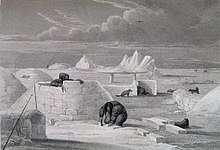
Several earlier indigenous peoples existed in the northern circumpolar regions of eastern Siberia, Alaska, and Canada (although probably not in Greenland[46]). The earliest positively identified Paleo-Eskimo cultures (Early Paleo-Eskimo) date to 5,000 years ago. They appear to have developed in Alaska from people related to the Arctic small tool tradition in eastern Asia, whose ancestors had probably migrated to Alaska at least 3,000 to 5,000 years earlier. Similar artifacts have been found in Siberia that date to perhaps 18,000 years ago.
The Yupik languages and cultures in Alaska evolved in place, beginning with the original pre-Dorset indigenous culture developed in Alaska. Approximately 4000 years ago, the Unangan culture of the Aleut became distinct. It is not generally considered an Eskimo culture.
Approximately 1,500–2,000 years ago, apparently in northwestern Alaska, two other distinct variations appeared. Inuit language became distinct and, over a period of several centuries, its speakers migrated across northern Alaska, through Canada and into Greenland. The distinct culture of the Thule people developed in northwestern Alaska and very quickly spread over the entire area occupied by Eskimo people, though it was not necessarily adopted by all of them.
Nomenclature
Origin
The most commonly accepted etymological origin of the word "Eskimo" is derived by Ives Goddard at the Smithsonian Institution, from the Montagnais (see Algonquian languages) word meaning "snowshoe-netter"[23] or "to net snowshoes".[22] The word assime·w means "she laces a snowshoe" in Montagnais. Montagnais speakers refer to the neighbouring Mi'kmaq people using words that sound like eskimo[47][48]
In 1978, Jose Mailhot, a Quebec anthropologist who speaks Montagnais, published a paper suggesting that Eskimo meant "people who speak a different language".[49][50] French traders who encountered the Montagnais in the eastern areas, adopted their word for the more western peoples and spelled it as Esquimau in a transliteration.
Some people consider Eskimo offensive because it is popularly perceived to mean[23][50][51][52] "eaters of raw meat" in Algonquian languages common to people along the Atlantic coast.[22][32][53] An unnamed Cree speaker suggested the original word that became corrupted to Eskimo might have been askamiciw (which means "he eats it raw"); the Inuit are referred to in some Cree texts as askipiw (which means "eats something raw").[32][53][54][55]
In some contexts, as applied to Inuit people, the continued use of "Eskimo" may reinforce a perception that the Inuit are unimportant and remote. The use of Eskimo in such contexts is often viewed as offensive.[56]
One of the first printed uses of the French word 'Esquimaux' comes from Samuel Hearne's A Journey from Prince of Wales's Fort in Hudson's Bay to the Northern Ocean in the Years 1769, 1770, 1771, 1772 first published in 1795.[57]
General
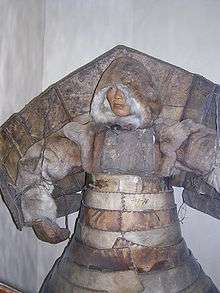
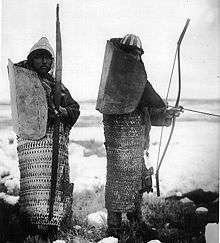
In Canada and Greenland, the term Eskimo has largely been supplanted by the term Inuit.[22][54][55][58] While Inuit can be accurately applied to all of the Eskimo peoples in Canada and Greenland, that is not true in Alaska and Siberia. In Alaska the term Eskimo is commonly used, because it includes both Yupik and Iñupiat. Inuit is not accepted as a collective term and it is not used specifically for Iñupiat (although they are related to the Canadian Inuit peoples).[22] One of the oldest known Eskimo archaeological sites, dating back to 3,800 years ago, is located in Saglek Bay, Labrador. On Umnak Island in the Aleutians, another site was found and is estimated to be an age of approximately 3,000 years old [59].
In 1977, the Inuit Circumpolar Conference (ICC) meeting in Utqiagvik, Alaska, officially adopted Inuit as a designation for all circumpolar native peoples, regardless of their local view on an appropriate term. As a result, the Canadian government usage has replaced the (locally) defunct term Eskimo with Inuit (Inuk in singular). The preferred term in Canada's Central Arctic is Inuinnaq,[60] and in the eastern Canadian Arctic Inuit. The language is often called Inuktitut, though other local designations are also used. Despite the ICC's 1977 decision to adopt the term Inuit, this was never accepted by the Yupik peoples, who likened it to calling all Native American Indians Navajo simply because the Navajo felt that that's what all tribes should be called.
The Inuit of Greenland refer to themselves as "Greenlanders" and speak the Greenlandic language.[61]
Because of the linguistic, ethnic, and cultural differences between Yupik and Inuit peoples, it seems unlikely that any umbrella term will be acceptable. There has been some movement to use Inuit, and the Inuit Circumpolar Council, representing a circumpolar population of 150,000 Inuit and Yupik people of Greenland, Northern Canada, Alaska, and Siberia, in its charter defines Inuit for use within that ICC document as including "the Inupiat, Yupik (Alaska), Inuit, Inuvialuit (Canada), Kalaallit (Greenland) and Yupik (Russia)".[62]
In 2010, the ICC passed a resolution in which they implored scientists to use "Inuit" and "Paleo-Inuit" instead of "Eskimo" or "Paleo-Eskimo".[63] American linguist Lenore Grenoble has explicitly deferred to this resolution and used "Inuit–Yupik" instead of "Eskimo" with regards to the language branch.[64] In a 2015 commentary in the journal Arctic, Canadian archaeologist Max Friesen argued fellow Arctic archaeologists should follow the ICC and use "Paleo-Inuit" instead of "Paleo-Eskimo".[65] In 2016, Lisa Hodgetts and Arctic editor Patricia Wells wrote: "In the Canadian context, continued use of any term that incorporates 'Eskimo' is potentially harmful to the relationships between archaeologists and the Inuit and Inuvialuit communities who are our hosts and increasingly our research partners"; they suggested using more specific terms when possible (e.g., Dorset and Groswater) and agreed with Frieson in using "the Inuit tradition" to replace "Neo-Eskimo", although they noted replacement for "Palaeoeskimo" was still an open question and discuss "Paleo-Inuit", "Arctic Small Tool Tradition", and "pre-Inuit", as well as Inuktitut loanwords like "Tuniit" and "Sivullirmiut" as possibilities.[66] One 2020 paper in Journal of Anthropological Archaeology, written by Katelyn Braymer-Hayes and colleagues, notes that there is a "clear need" to replace the terms "Neo-Eskimo" and "Paleo-Eskimo", citing the ICC resolution, but finding a consensus within the Alaskan context particularly is difficult, since Alaska Natives do not use the word Inuit to describe themselves, nor is the term legally applicable only to Inupiat and Yupik peoples in Alaska, and as such, terms used in Canada like "Paleo Inuit" and "Ancestral Inuit" would not be acceptable.[67]
But, in Alaska, the Inuit people refer to themselves as Iñupiat, plural, and Iñupiaq, singular (their North Alaskan Inupiatun language is also called Iñupiaq). They do not commonly use the term Inuit. In Alaska, Eskimo has been commonly used but is decreasing in prevalence.[22]
Alaskans also use the term Alaska Native, which is inclusive of all Eskimo, Aleut and other Native Americans of Alaska. It does not apply to Inuit or Yupik people originating outside the state. The term Alaska Native has important legal usage in Alaska and the rest of the United States as a result of the Alaska Native Claims Settlement Act of 1971.
The term "Eskimo" is also used in linguistic or ethnographic works to denote the larger branch of Eskimo–Aleut languages, the smaller branch being Aleut.
Languages
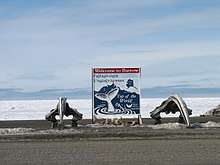
The Eskimo–Aleut family of languages includes two cognate branches: the Aleut (Unangan) branch and the Eskimo branch.
The number of cases varies, with Aleut languages having a greatly reduced case system compared to those of the Eskimo subfamily. Eskimo–Aleut languages possess voiceless plosives at the bilabial, coronal, velar and uvular positions in all languages except Aleut, which has lost the bilabial stops but retained the nasal. In the Eskimo subfamily a voiceless alveolar lateral fricative is also present.
The Eskimo sub-family consists of the Inuit language and Yupik language sub-groups.[68] The Sirenikski language, which is virtually extinct, is sometimes regarded as a third branch of the Eskimo language family. Other sources regard it as a group belonging to the Yupik branch.[68][69]
Inuit languages comprise a dialect continuum, or dialect chain, that stretches from Unalakleet and Norton Sound in Alaska, across northern Alaska and Canada, and east to Greenland. Changes from western (Iñupiaq) to eastern dialects are marked by the dropping of vestigial Yupik-related features, increasing consonant assimilation (e.g., kumlu, meaning "thumb", changes to kuvlu, changes to kublu,[70] changes to kulluk,[70] changes to kulluq[70]), and increased consonant lengthening, and lexical change. Thus, speakers of two adjacent Inuit dialects would usually be able to understand one another, but speakers from dialects distant from each other on the dialect continuum would have difficulty understanding one another.[69] Seward Peninsula dialects in western Alaska, where much of the Iñupiat culture has been in place for perhaps less than 500 years, are greatly affected by phonological influence from the Yupik languages. Eastern Greenlandic, at the opposite end of the Inuit range, has had significant word replacement due to a unique form of ritual name avoidance.[68][69]
The four Yupik languages, by contrast, including Alutiiq (Sugpiaq), Central Alaskan Yup'ik, Naukan (Naukanski), and Siberian Yupik, are distinct languages with phonological, morphological, and lexical differences. They demonstrate limited mutual intelligibility.[68] Additionally, both Alutiiq and Central Yup'ik have considerable dialect diversity. The northernmost Yupik languages – Siberian Yupik and Naukan Yupik – are linguistically only slightly closer to Inuit than is Alutiiq, which is the southernmost of the Yupik languages. Although the grammatical structures of Yupik and Inuit languages are similar, they have pronounced differences phonologically. Differences of vocabulary between Inuit and any one of the Yupik languages are greater than between any two Yupik languages.[69] Even the dialectal differences within Alutiiq and Central Alaskan Yup'ik sometimes are relatively great for locations that are relatively close geographically.[69] Despite the relatively small population of Naukan speakers, documentation of the language dates back to 1732. While Naukan is only spoken in Siberia, the language acts as an intermediate between two Alaskan languages: Siberian Yupik Eskimo and Central Yup'ik Eskimo.[71]
The Sirenikski language is sometimes regarded as a third branch of the Eskimo language family, but other sources regard it as a group belonging to the Yupik branch.[69]

An overview of the Eskimo–Aleut languages family is given below:
- Aleut
- Aleut language
- Western-Central dialects: Atkan, Attuan, Unangan, Bering (60–80 speakers)
- Eastern dialect: Unalaskan, Pribilof (400 speakers)
- Aleut language
- Eskimo (Yup'ik, Yuit, and Inuit)
- Yupik
- Central Alaskan Yup'ik (10,000 speakers)
- Alutiiq or Pacific Gulf Yup'ik (400 speakers)
- Central Siberian Yupik or Yuit (Chaplinon and St Lawrence Island, 1,400 speakers)
- Naukan (700 speakers)
- Inuit or Inupik (75,000 speakers)
- Iñupiaq (northern Alaska, 3,500 speakers)
- Inuvialuktun (western Canada; together with Siglitun, Natsilingmiutut, Inuinnaqtun and Uummarmiutun 765 speakers)
- Inuktitut (eastern Canada; together with Inuktun and Inuinnaqtun, 30,000 speakers)
- Kalaallisut (Greenlandic (Greenland, 47,000 speakers)
- Inuktun (Avanersuarmiutut, Thule dialect or Polar Eskimo, approximately 1,000 speakers)
- Tunumiit oraasiat (East Greenlandic known as Tunumiisut, 3,500 speakers)
- Sirenik Eskimo language (Sirenikskiy) (extinct)
- Yupik
Inuit

The Inuit inhabit the Arctic and northern Bering Sea coasts of Alaska in the United States, and Arctic coasts of the Northwest Territories, Nunavut, Quebec, and Labrador in Canada, and Greenland (associated with Denmark). Until fairly recent times, there has been a remarkable homogeneity in the culture throughout this area, which traditionally relied on fish, marine mammals, and land animals for food, heat, light, clothing, and tools. Their food sources primarily relied on seals, whales, whale blubber, walrus, and fish, all of which they hunted using harpoons on the ice. [72] Clothing consisted of robes made of wolfskin and reindeer skin to acclimate to the low temperatures.[73] They maintain a unique Inuit culture.
Greenland's Inuit
Greenlandic Inuit make up 90% of Greenland's population.[74] They belong to three major groups:
- Kalaallit of west Greenland, who speak Kalaallisut
- Tunumiit of east Greenland, who speak Tunumiisut
- Inughuit of north Greenland, who speak Inuktun or Polar Eskimo.[61]
Inuit of Canada's Eastern Arctic
Canadian Inuit live primarily in Nunavut (a territory of Canada), Nunavik (the northern part of Quebec) and in Nunatsiavut (the Inuit settlement region in Labrador).
Inuvialuit of Canada's Western Arctic
.jpg)
The Inuvialuit live in the western Canadian Arctic region. Their homeland – the Inuvialuit Settlement Region – covers the Arctic Ocean coastline area from the Alaskan border east to Amundsen Gulf and includes the western Canadian Arctic Islands. The land was demarked in 1984 by the Inuvialuit Final Agreement.
Alaska's Iñupiat
The Iñupiat are the Inuit of Alaska's Northwest Arctic and North Slope boroughs and the Bering Straits region, including the Seward Peninsula. Utqiagvik, the northernmost city in the United States, is above the Arctic Circle and in the Iñupiat region. Their language is known as Iñupiaq.[75]
Yupik

The Yupik are indigenous or aboriginal peoples who live along the coast of western Alaska, especially on the Yukon-Kuskokwim delta and along the Kuskokwim River (Central Alaskan Yup'ik); in southern Alaska (the Alutiiq); and along the eastern coast of Chukotka in the Russian Far East and St. Lawrence Island in western Alaska (the Siberian Yupik).[76] The Yupik economy has traditionally been strongly dominated by the harvest of marine mammals, especially seals, walrus, and whales.[77]
Alutiiq
The Alutiiq, also called Pacific Yupik or Sugpiaq, are a southern, coastal branch of Yupik. They are not to be confused with the Aleut, who live further to the southwest, including along the Aleutian Islands. They traditionally lived a coastal lifestyle, subsisting primarily on ocean resources such as salmon, halibut, and whales, as well as rich land resources such as berries and land mammals. Alutiiq people today live in coastal fishing communities, where they work in all aspects of the modern economy. They also maintain the cultural value of a subsistence lifestyle.
The Alutiiq language is relatively close to that spoken by the Yupik in the Bethel, Alaska area. But, it is considered a distinct language with two major dialects: the Koniag dialect, spoken on the Alaska Peninsula and on Kodiak Island, and the Chugach dialect, spoken on the southern Kenai Peninsula and in Prince William Sound. Residents of Nanwalek, located on southern part of the Kenai Peninsula near Seldovia, speak what they call Sugpiaq. They are able to understand those who speak Yupik in Bethel. With a population of approximately 3,000, and the number of speakers in the hundreds, Alutiiq communities are working to revitalize their language.[78]
Central Alaskan Yup'ik
Yup'ik, with an apostrophe, denotes the speakers of the Central Alaskan Yup'ik language, who live in western Alaska and southwestern Alaska from southern Norton Sound to the north side of Bristol Bay, on the Yukon–Kuskokwim Delta, and on Nelson Island. The use of the apostrophe in the name Yup'ik is a written convention to denote the long pronunciation of the p sound; but it is spoken the same in other Yupik languages. Of all the Alaska Native languages, Central Alaskan Yup'ik has the most speakers, with about 10,000 of a total Yup'ik population of 21,000 still speaking the language. The five dialects of Central Alaskan Yup'ik include General Central Yup'ik, and the Egegik, Norton Sound, Hooper Bay-Chevak, and Nunivak dialects. In the latter two dialects, both the language and the people are called Cup'ik.[79]
Siberian Yupik

Siberian Yupik reside along the Bering Sea coast of the Chukchi Peninsula in Siberia in the Russian Far East[69] and in the villages of Gambell and Savoonga on St. Lawrence Island in Alaska.[80] The Central Siberian Yupik spoken on the Chukchi Peninsula and on St. Lawrence Island is nearly identical. About 1,050 of a total Alaska population of 1,100 Siberian Yupik people in Alaska speak the language. It is the first language of the home for most St. Lawrence Island children. In Siberia, about 300 of a total of 900 Siberian Yupik people still learn and study the language, though it is no longer learned as a first language by children.[80]
Naukan
About 70 of 400 Naukan people still speak Naukanski. The Naukan originate on the Chukot Peninsula in Chukotka Autonomous Okrug in Siberia.[69] Despite the relatively small population of Naukan speakers, documentation of the language dates back to 1732. While Naukan is only spoken in Siberia, the language acts as an intermediate between two Alaskan languages: Siberian Yupik Eskimo and Central Yup'ik Eskimo.[81]
Sirenik Eskimos
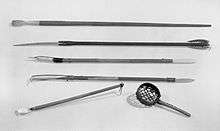
Some speakers of Siberian Yupik languages used to speak an Eskimo variant in the past, before they underwent a language shift. These former speakers of Sirenik Eskimo language inhabited the settlements of Sireniki, Imtuk, and some small villages stretching to the west from Sireniki along south-eastern coasts of Chukchi Peninsula.[82] They lived in neighborhoods with Siberian Yupik and Chukchi peoples.
As early as in 1895, Imtuk was a settlement with a mixed population of Sirenik Eskimos and Ungazigmit[83] (the latter belonging to Siberian Yupik). Sirenik Eskimo culture has been influenced by that of Chukchi, and the language shows Chukchi language influences.[84] Folktale motifs also show the influence of Chuckchi culture.[85]
The above peculiarities of this (already extinct) Eskimo language amounted to mutual unintelligibility even with its nearest language relatives:[86] in the past, Sirenik Eskimos had to use the unrelated Chukchi language as a lingua franca for communicating with Siberian Yupik.[84]
Many words are formed from entirely different roots from in Siberian Yupik,[87] but even the grammar has several peculiarities distinct not only among Eskimo languages, but even compared to Aleut. For example, dual number is not known in Sirenik Eskimo, while most Eskimo–Aleut languages have dual,[88] including its neighboring Siberian Yupikax relatives.[89]
Little is known about the origin of this diversity. The peculiarities of this language may be the result of a supposed long isolation from other Eskimo groups,[90][91] and being in contact only with speakers of unrelated languages for many centuries. The influence of the Chukchi language is clear.[84]
Because of all these factors, the classification of Sireniki Eskimo language is not settled yet:[92] Sireniki language is sometimes regarded as a third branch of Eskimo (at least, its possibility is mentioned).[92][93][94] Sometimes it is regarded rather as a group belonging to the Yupik branch.[95][96]
See also
References
- Pamela R. Stern (2013). Historical Dictionary of the Inuit. Scarecrow Press. p. 2. ISBN 978-0-8108-7912-6.
- "Eskimo | Definition, History, Culture, & Facts". Encyclopedia Britannica.
- "Arctic Studies". alaska.si.edu.
- Reich, David (2018). Who We Are and How We Got Here: Ancient DNA and the New Science of the Human Past. New York: Pantheon Books.
- https://www150.statcan.gc.ca/n1/daily-quotidien/171025/mc-a001-eng.htm
- https://www.cia.gov/library/publications/the-world-factbook/geos/gl.html
- https://www.statistikbanken.dk/BEF5G
- U.S. Census Bureau, Census 2000 PHC-T-18. American Indian and Alaska Native Tribes in the United States: 2000
- https://www.census.gov/prod/cen2010/briefs/c2010br-10.pdf
- https://www.britannica.com/topic/Eskimo-people
- https://www.inuitcircumpolar.com/
- "Words First An Evolving Terminology Relating to Aboriginal Peoples in Canada Communications Branch Indian and Northern Affairs Canada October 2002" (PDF). June 8, 2020.
The term "Eskimo,"applied to Inuit by European explorers, is no longer used in Canada.
- Inuit
- MacDonald-Dupuis, Natasha (December 16, 2015). "The Little-Known History of How the Canadian Government Made Inuit Wear 'Eskimo Tags'".
- "Obama signs measure to get rid of the word 'Eskimo' in federal laws". Anchorage Daily News. 2016-05-24. Retrieved 2020-07-14.
- Meng, Grace (2016-05-20). "Text - H.R.4238 - 114th Congress (2015-2016): To amend the Department of Energy Organization Act and the Local Public Works Capital Development and Investment Act of 1976 to modernize terms relating to minorities". www.congress.gov. Retrieved 2020-07-14.
- https://www.govinfo.gov/content/pkg/FR-2020-01-30/pdf/2020-01707.pdf
- https://www.bia.gov/frequently-asked-questions
- https://www.usaonrace.com/sticky-wicket-questions/1462/is-the-term-eskimo-a-racial-or-ethnic-insult.html
- https://www.nationalgeographic.com/news/2014/8/140828-arctic-migration-genome-genetics-dna-eskimos-inuit-dorset/
- https://www.factmonster.com/eskimos#:~:text=Eskimos%20are%20racially%20distinct%20from,Inuit%E2%80%9D%20(The%20People)
- Kaplan, Lawrence. "Inuit or Eskimo: Which name to use?" Alaskan Native Language Center, UAF. Retrieved 14 Feb 2015.
- Israel, Mark. "Eskimo". Alt-usage-english.org. Archived from the original on 2012-04-03. Retrieved 2012-06-13.
- R. H. Ives Goddard, "Synonymy". In David Damas (ed.) Handbook of North American Indians: Volume 5 Arctic (Washington, DC: Smithsonian Institution, 1985, 978-0874741858), pages 5–7.
- stason.org, Stas Bekman: stas (at). "91 "Eskimo" (Word origins - alt.usage.english)". stason.org.
- Maurice Waite (2013). Pocket Oxford English Dictionary. OUP Oxford. p. 305. ISBN 978-0-19-966615-7.
Some people regard the word Eskimo as offensive, and the peoples inhabiting the regions of northern Canada and parts of Greenland and Alaska prefer to call themselves Inuit
- Jan Svartvik; Geoffrey Leech (2016). English – One Tongue, Many Voices. Palgrave Macmillan UK. p. 97. ISBN 978-1-137-16007-2.
Today, the term "Eskimo" is viewed as the "non preferred term". Some Inuit find the term offensive or derogatory.
- "Inuit or Eskimo? - Alaska Native Language Center". Archived from the original on 2015-05-18. Retrieved 2017-04-19.
Although the name 'Eskimo' is commonly used in Alaska to refer to all Inuit and Yupik people of the world, this name is considered derogatory in many other places because it was given by non-Inuit people and was said to mean 'eater of raw meat'.
- "Obama signs measure to get rid of the word 'Eskimo' in federal laws". 24 May 2016.
- Why You Probably Shouldn't Say 'Eskimo'
- Expert says ‘meat-eater’ name Eskimo an offensive term placed on Inuit
- "Setting the Record Straight About Native Languages: What Does "Eskimo" Mean In Cree?". Native-languages.org. Retrieved 2012-06-13.
- Alexander, Colin (2013-12-13). "Where does the word "Eskimo" come from?". Nunatsiaq News. Retrieved 2020-07-21.
"In spite of the tenacity of the belief, both among Algonquian speakers and in the anthropological and general literature…that Eskimo means ‘raw-meat eaters’
- McGrath, Melanie (2006). The Long Exile: A Tale of Inuit Betrayal and Survival in the High Arctic. Knopf Doubleday Publishing Group. ISBN 978-0-307-53786-7.
- James, Matt (2008). "Wrestling with the Past: Apologies, Quasi-Apologies and Non-Apologies in Canada". In Mark Gibney; Rhoda E. Howard-Hassmann; Jean-Marc Coicaud; Niklaus Steiner (eds.). The Age of Apology. University of Pennsylvania Press. pp. 142–144. ISBN 978-0-8122-4033-7.
- Marcus, Alan Rudolph (1995). Relocating Eden: The Image and Politics of Inuit Exile in the Canadian Arctic. University Press of New England. pp. 70–71.
- "Canadian Charter of Rights and Freedoms". Department of Justice Canada. Retrieved August 30, 2012.
- "Rights of the Aboriginal Peoples of Canada". Department of Justice Canada. Retrieved August 30, 2012.
- Padilla, Lissette (July 13, 2015). "Are There Still Eskimos?". Seeker. Retrieved June 18, 2020.
- https://www.uaf.edu/anlc/resources/inuit_or_eskimo.php#:~:text=Although%20the%20name%20%22Eskimo%22%20is,%22eater%20of%20raw%20meat.%22&text=However%2C%20the%20people%20of%20Canada%20and%20Greenland%20prefer%20other%20names.
- https://www.alaskan-natives.com/2166/eskimo-inuit-inupiaq-terms-thing/#:~:text=Inuk%20%E2%80%93%20Singular%20form%20of%20Inuit%2C%20meaning%20%E2%80%9Chuman%20being.%E2%80%9D&text=Inuit%20%E2%80%93%20This%20is%20the%20plural,people's%20traditional%20name%20for%20themselves.&text=Inupiaq%20%E2%80%93%20In%20Alaska%20and%20Arctic,usage%20in%20English%20as%20Inuit.
- Houghton Mifflin Company (2005). The American Heritage Guide to Contemporary Usage and Style. Houghton Mifflin Harcourt. p. 313. ISBN 0-618-60499-5.
- "Native American populations descend from three key migrations". UCL News. University College London. 2012-07-12. Retrieved 2018-12-12.
- Holton, Gary. "Place-naming strategies in Inuit–Yupik and Dene languages in Alaska"., Academia.edu, Retrieved 27 Jan 2014.
- https://www.britannica.com/topic/Eskimo-people
- "- Saqqaq". April 19, 2011. Archived from the original on April 19, 2011.
- Goddard, Ives (1984). "Synonymy", In Arctic, ed. David Damas. Vol. 5 of Handbook of North American Indians, ed. William C. Sturtevant, pp. 5–7. Washington, D.C.: Smithsonian Institution. Cited in Campbell 1997
- Campbell, Lyle (1997). American Indian Languages: The Historical Linguistics of Native America, pg. 394. New York: Oxford University Press
- Mailhot, J. (1978). "L'étymologie de «Esquimau» revue et corrigée", Etudes Inuit/Inuit Studies 2-2:59–70.
- "Cree Mailing List Digest November 1997". Retrieved 2012-06-13.
- Mailhot, Jose (1978). "L'etymologie de "esquimau" revue et corrigée". Etudes/Inuit/Studies. 2 (2).
- Goddard, Ives (1984). Handbook of North American Indians, Vol. 5 (Arctic). Smithsonian Institution. ISBN 978-0-16-004580-6.
- "Eskimo". American Heritage Dictionary of the English Language: Fourth Edition, 2000. Bartleby. Archived from the original on 2001-04-12. Retrieved 2008-01-13.
- Pamela R. Stern (2004-07-27). Historical Dictionary of the Inuit. ISBN 9780810865563. Retrieved 2012-06-13.
- Robert Peroni and Birgit Veith. "Ostgroenland-Hilfe Project". Ostgroenland-hilfe.de. Archived from the original on 2012-03-18. Retrieved 2012-06-13.
- "Eskimo | The Canadian Encyclopedia". thecanadianencyclopedia.ca. Retrieved 2020-02-19.
- The Project Gutenberg eBook of A Journey from Prince of Wales's Fort in Hudson's Bay to the Northern Ocean, by Samuel Hearne. www.gutenberg.org.
- Usage note, "Inuit", American Heritage Dictionary of the English Language: Fourth Edition, 2000
- https://www.britannica.com/topic/Eskimo-people
- Ohokak, G.; M. Kadlun; B. Harnum. Inuinnaqtun-English Dictionary. Kitikmeot Heritage Society.
- "Inuktitut, Greenlandic". Ethnologue. Retrieved 6 Aug 2012.
- Inuit Circumpolar Council. (2006). Charter Archived March 5, 2010, at the Wayback Machine Retrieved on 2007-04-06.
- Inuit Circumpolar Council (2010). "On the use of the term Inuit in scientific and other circles" (PDF) (Resolution 2010-01).
- Grenoble, Lenore A. (2016). "Kalaallisut: The Language of Greenland". In Day, Delyn; Rewi, Poia; Higgins, Rawinia (eds.). The Journeys of Besieged Languages. Cambridge Scholars. p. 284. ISBN 978-1-4438-9943-7.
- Friesen, T. Max (2015). "On the Naming of Arctic Archaeological Traditions: The Case for Paleo-Inuit". Arctic. 68 (3): iii–iv. doi:10.14430/arctic4504. hdl:10515/sy5sj1b75.
- Hodgetts, Lisa; Wells, Patricia (2016). "Priscilla Renouf Remembered: An Introduction to the Special Issue with a Note on Renaming the Palaeoeskimo Tradition". Arctic. 69 (5). doi:10.14430/arctic4678.
- Braymer-Hayes, Katelyn; Anderson, Shelby L.; Alix, Claire; Darwent, Christyann M.; Darwent, John; Mason, Owen K.; Norman, Lauren Y.E. (2020). "Studying pre-colonial gendered use of space in the Arctic: Spatial analysis of ceramics in Northwestern Alaska". Journal of Anthropological Archaeology. 58: 101165. doi:10.1016/j.jaa.2020.101165.
- Michael Fortescue; Steven Jacobson; Lawance Kaplan. Comparative Eskimo Dictionary with Aleut Cognates. Alaska Native Language Center, University of Alaska Fairbanks.
- Kaplan, Lawrence. (2001-12-10). "Comparative Yupik and Inuit" Archived 2015-05-16 at the Wayback Machine. Alaska Native Language Center, University of Alaska Fairbanks. Retrieved on August 30, 2012.
- "thumb". Asuilaak Living Dictionary. Retrieved 2007-11-25.
- Jacobson, Steven A. “History of the Naukan Yupik Eskimo Dictionary with Implications for a Future Siberian Yupik Dictionary – Études/Inuit/Studies.” Érudit, Association Inuksiutiit Katimajiit Inc., 13 Nov. 2006, www.erudit.org/en/journals/etudinuit/1900-v1-n1-etudinuit1430/013937ar/.
- https://www.britannica.com/topic/Eskimo-people
- Nelson, Edward William. The Eskimo about Bering Strait. U.S. G.P.O., 1899.
- "Greenland". CIA World Factbook. Accessed 14 May 2014.
- "Inupiatun". Alaska Native Languages. Alaska Humanities Forum. n.d. Retrieved 19 June 2020.
Iñupiaq is spoken by the Iñupiat on the Seward Peninsula, the Northwest Arctic and the North Slope of Alaska
- "Facts for Kids: Yup'ik People (Yupik)". www.bigorrin.org. Retrieved 2020-06-20.
- "Yupik". (2008). In Encyclopædia Britannica. Retrieved January 13, 2008, from: Encyclopædia Britannica Online Retrieved August 30, 2012.
- "Language Loss & Revitalization". alutiiqmuseum.org. Retrieved 2018-06-12.
- "Central Alaskan Yup'ik". Alaska Native Language Center. University of Alaska Fairbanks. Archived from the original on February 6, 2007. Retrieved 2007-04-06.
- Alaska Native Language Center. (2001-12-07).St. Lawrence Island Yupik (Siberian Yupik). Alaska Native Language Center, University of Alaska Fairbanks. Retrieved on August 30, 2012.
- Jacobson, Steven A. “History of the Naukan Yupik Eskimo Dictionary with Implications for a Future Siberian Yupik Dictionary – Études/Inuit/Studies.” Érudit, Association Inuksiutiit Katimajiit Inc., 13 Nov. 2006, www.erudit.org/en/journals/etudinuit/1900-v1-n1-etudinuit1430/013937ar/.
- Vakhtin 1998: 162
- Menovshchikov 1964: 7
- Menovshchikov 1990: 70
- Menovshchikov 1964: 132
- Menovshchikov 1964: 6–7
- Menovshchikov 1964: 42
- Menovshchikov 1964: 38
- Menovshchikov 1964: 81
- Menovshchikov 1962: 11
- Menovshchikov 1964: 9
- Vakhtin 1998: 161
- Linguist List's description about Nikolai Vakhtin's book: The Old Sirinek Language: Texts, Lexicon, Grammatical Notes. The author's untransliterated (original) name is "Н.Б. Вахтин Archived September 10, 2007, at the Wayback Machine".
- Языки эскимосов. ICC Chukotka (in Russian). Inuit Circumpolar Council. Archived from the original on 2014-10-26.
- "Ethnologue Report for Eskimo–Aleut". Ethnologue.com. Retrieved 2012-06-13.
- Kaplan 1990: 136
Sources
- Kaplan, Lawrence D. (1990). "The Language of the Alaskan Inuit" (PDF). In Dirmid R. F. Collis (ed.). Arctic Languages. An Awakening. Vendôme: UNESCO. pp. 131–158. ISBN 92-3-102661-5.
- Menovshchikov, Georgy (= Г. А. Меновщиков) (1990). "Contemporary Studies of the Eskimo–Aleut Languages and Dialects: A Progress Report" (PDF). In Dirmid R. F. Collis (ed.). Arctic Languages. An Awakening. Vendôme: UNESCO. pp. 69–76. ISBN 92-3-102661-5.
- Nuttall, Mark. Encyclopedia of the Arctic. New York: Routledge, 2005. ISBN 978-1-57958-436-8.
- Vakhtin, Nikolai (1998). "Endangered Languages in Northeast Siberia: Siberian Yupik and other Languages of Chukotka". In Erich Kasten (ed.). Bicultural Education in the North: Ways of Preserving and Enhancing Indigenous Peoples' Languages and Traditional Knowledge (PDF). Münster: Waxmann Verlag. pp. 159–173. ISBN 978-3-89325-651-8. Archived from the original (PDF) on 2007-04-13. Retrieved 2019-04-22.
Cyrillic
- Menovshchikov, Georgy (1964). Язык сиреникских эскимосов. Фонетика, очерк морфологии, тексты и словарь [Language of Sireniki Eskimos. Phonetics, morphology, texts and vocabulary] (in Russian). Москва, Ленинград: Академия Наук СССР. Институт языкознания.
Further reading
| Wikimedia Commons has media related to Eskimo. |
| Look up eskimo or Eskimo in Wiktionary, the free dictionary. |
- Adapting to climate change: social-ecological resilience in a Canadian western arctic community. Conservation Ecology 5(2)
- Canadian Council on Learning, State of Inuit Learning in Canada
- Contemporary Food Sharing: A Case Study from Akulivik, PQ. Canada.
- Internet Sacred Text Archive: Inuit Religion
- Inuit Culture
- Inuit Exposure to Organochlorines through the Aquatic Food Chain. Environmental Health Perspectives 101(7)
- Inuit Women and Graphic Arts: Female Creativity and Its Cultural Context. The Canadian Journal of Native Studies 9(2)
- We the People: American Indians and Alaska Natives in the United States. Census 2000 Special Reports February 2006
- University of Washington Libraries Digital Collections – Frank H. Nowell Photographs Photographs documenting scenery, towns, businesses, mining activities, Native Americans, and Eskimos in the vicinity of Nome, Alaska from 1901 to 1909.
- University of Washington Libraries Digital Collections – Alaska and Western Canada Collection Images documenting Alaska and Western Canada, primarily Yukon and British Columbia, depicting scenes of the Gold Rush of 1898, city street scenes, Eskimo and Native Americans of the region, hunting and fishing, and transportation.
- University of Washington Libraries Digital Collections – Arthur Churchill Warner Photographs Includes images of Eskimos from 1898 to 1900.
- Inuit Myopia
External links
- Some Psychological Aspects of the Impact of the White Man upon the Labrador Eskimo Manuscript at Dartmouth College Library
- The Traditional Labrador Eskimos (1960) Manuscript at Dartmouth College Library
- Victor Levine Manuscripts on origins of the Eskimos at Dartmouth College Library
